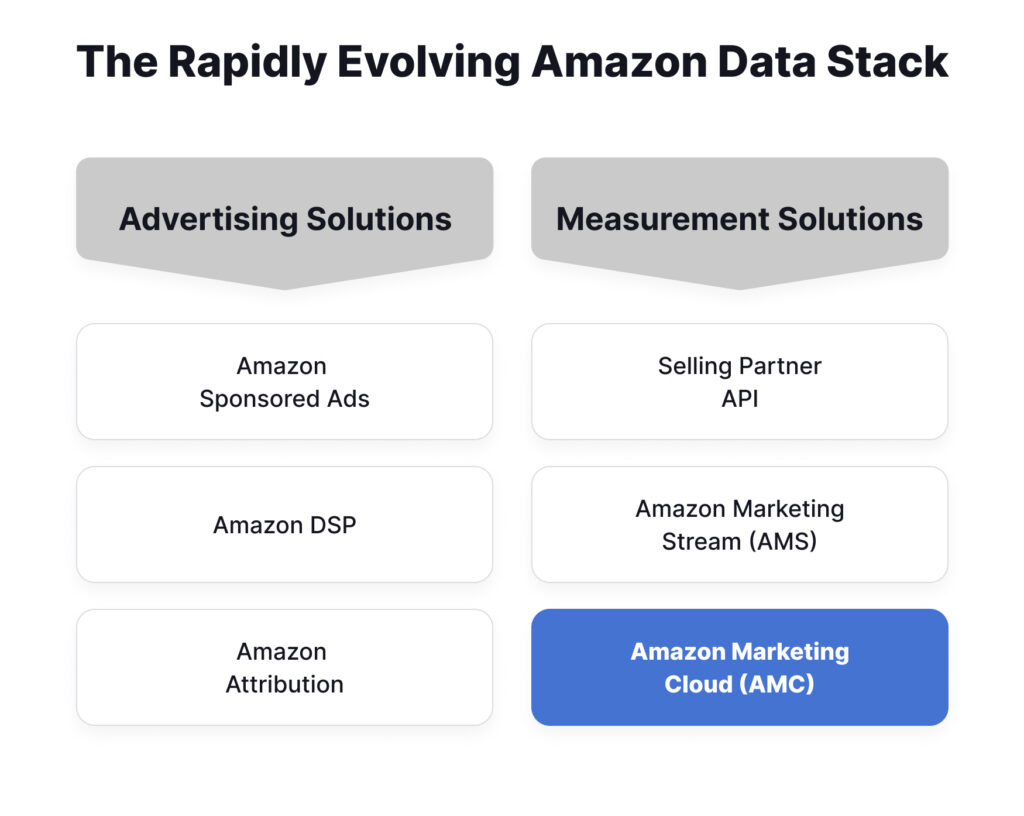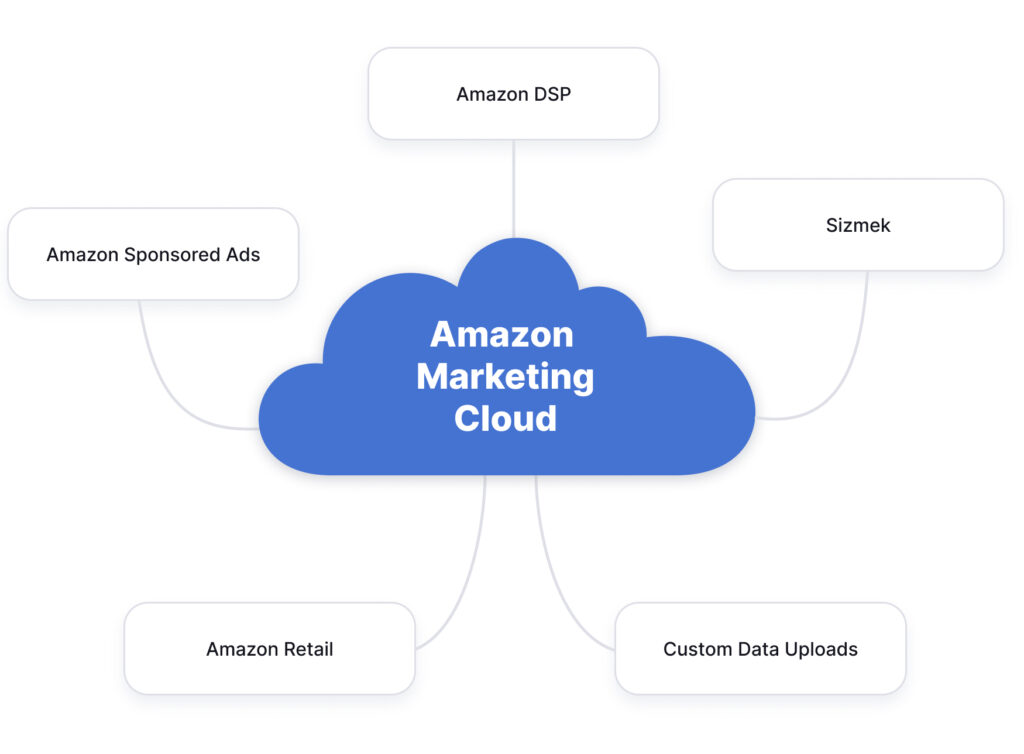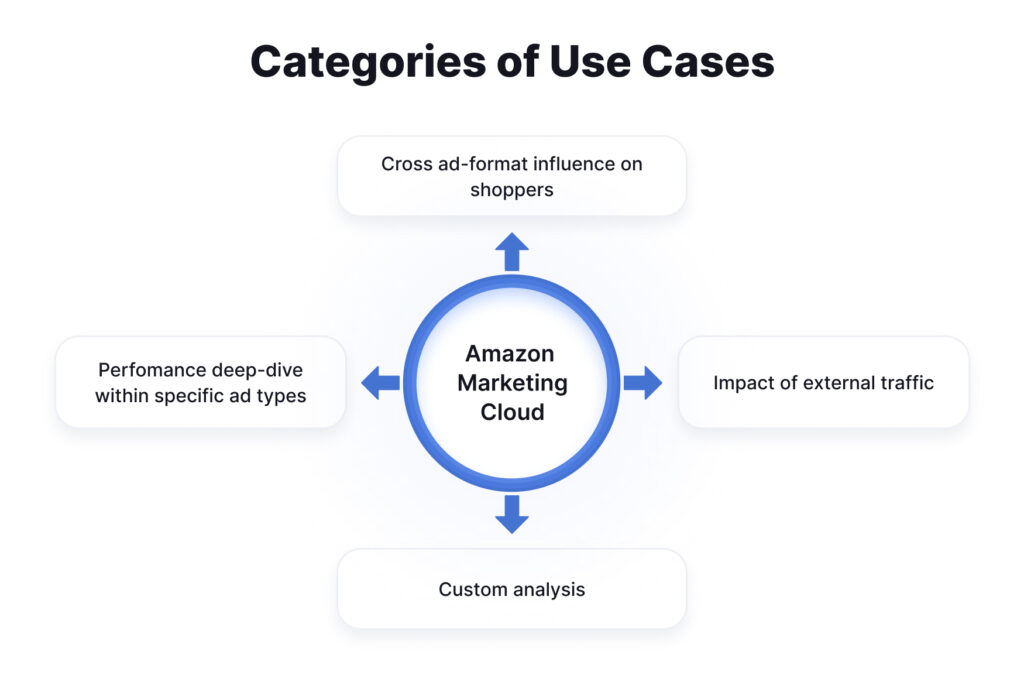Amazon’s ad stack has grown from Sponsored Ads to a much more robust ecosystem that helps advertisers better understand their customers’ wants and decisions, both on Amazon and well beyond.
The company continues to unveil more and more data that can be leveraged in advertising and overall channel optimization. Think of the Amazon ad stack in two layers: advertising and data/insights. Advertising includes Amazon Sponsored Ads, Amazon DSP (demand-side platform), and Amazon Attribution. Data/insights, on the other hand, includes the Sponsored Products API, Amazon Marketing Stream, and Amazon Marketing Cloud. Whether you are a brand/seller, agency, or aggregator, staying competitive will require a focus on building the internal muscle to effectively use the data/insights layer of the Amazon ad stack.

Reorient to the new center of Amazon advertising measurement
In this post, I’m focusing on just one important part of the ecosystem—Amazon Marketing Cloud (AMC), which was announced in January of last year. “Amazon Marketing Cloud is a secure, privacy-safe, and dedicated cloud-based environment in which advertisers can easily perform analytics across multiple, pseudonymized data sets to generate aggregated reports,” the company wrote at the time. AMC is a comprehensive dataset that brings together a variety of customer touchpoints, from offline traffic to retail data.
Before AMC, performance metrics were accessible within separate ad products such as Amazon Ads and Amazon DSP. These metrics weren’t connected to each other, so it wasn’t possible to understand the influence of these various campaigns and ad formats on a shopper. AMC has changed all that. By connecting these siloed datasets at a very, very fine grain, AMC enables much more analysis than ever before, as well as creates a greater understanding of the customer journey.
See what your customer sees before a purchase
AMC brings together a variety of different types of data to allow for analysis across the platforms. This data includes:
- Amazon DSP
- Amazon Sponsored Ads
- Sizmek Ad Suite
- Paid subscriptions (non-ad-exposed shopper data)
- Data that’s uploaded by an advertiser, such as direct-to-consumer sales

AMC collects a range of “event-level data” that a shopper goes through—such as impressions, clicks, and conversions—and allows advertisers to stitch together that information at a very fine grain (for example, by timestamp and user id). AMC is a clean room environment, where data is managed in a privacy-compliant way. This means advertisers can string together complete customer shopping journeys. Compared to prior data, this gives a much richer picture into everything that potentially influenced that final purchase.

Recently, Amazon launched “paid features” for AMC. With the paid version, advertisers can access a dataset called “conversion_non_ad_exposed,” which shows conversion events from users who haven’t been exposed to ads in the previous 28 days. This means it’s now possible to compare metrics—such as percent of users, overall sales, and per-user revenue—between two segments of users, ad-exposed vs. not. Advertisers can examine the behavior differences between users who were exposed to ads vs. those that weren’t.
Better understand what influences a purchase
With AMC, advertisers can better understand the interplay of DSP and search advertising on overall sales, the impact of Sponsored Display ads on brand searches, and first touch/multi-touch attribution modeling, among others. For example, if a shopper interacted with DSP ad for shampoo and then an Amazon Sponsored Products ad for that same shampoo, AMC can help an advertiser stitch those interactions together and see patterns.
Start with SQL to take full advantage of AMC
The more you can explore AMC data, the more you can get out of it. To do that successfully, someone on your team needs to have the training and skills in Structured Query Language (SQL) to tweak AMC’s example SQL queries to answer your company’s unique questions. If you want to learn SQL basics, we offer a self-serve SQL 101 training available on-demand.
Pay attention—or get left behind
Amazon advertising continues to get more and more competitive, and it’s clear that Amazon is going to make AMC the centerpiece of its advertising measurement. AMC is the most fine-grained data advertisers can get right now, and they must leverage this data to optimize, compete effectively, and maximize outcomes.
One final note: Don’t approach AMC as yet another dashboard tool. AMC should be treated as a source of answers to interesting, hard, strategically important questions that’ll ultimately give advertisers a competitive advantage.
Advertisers who are currently leveraging Amazon DSP can access Amazon Marketing Cloud (AMC) using our custom solution. Learn more about our AMC solution here.







